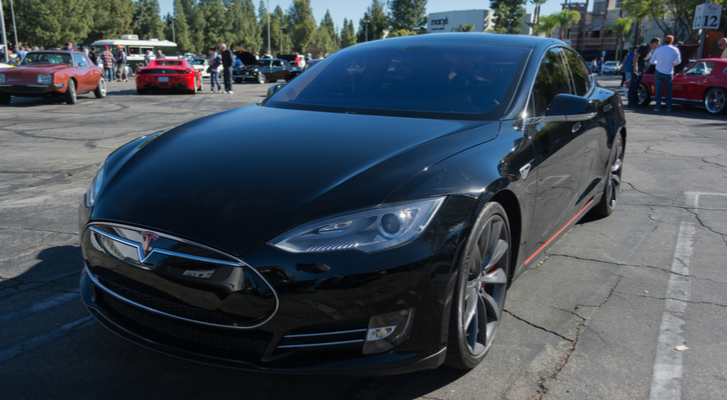Tesla (NASDAQ:TSLA) is arguably the biggest battleground stock in the market. On one end, you have bulls who think Tesla is changing the world and that Tesla stock is heading for the moon in the long run (much like its founder Elon Musk). On the other end, you have bears who think Tesla is on the verge of bankruptcy and that Tesla stock is heading for the graveyard.
Because of this stark bull-bear dynamic, Tesla stock is high-risk, high-reward. And, unless you can stomach the volatility inherent with owning this type of stock, you should forget about TSLA.
But, if you can stomach the volatility, then Tesla stock could be a nice pick-up at $250. The $250 level has shown surprisingly strong support for this stock. Near-term production, delivery and profitability fundamentals appear to be improving. The long-term growth narrative is becoming more clear.
Overall, Tesla stock is still high risk, but the rewards appear to justify the risks. The stock needs a catalyst to reverse sentiment and get it back on an uptrend. That catalyst won’t arrive until the third-quarter earnings report. Thus, the best game-plan is to accumulate on dips towards $250, and wait for the Q3 report.
The High-Reward Part of Tesla
If everything goes right for Tesla in its transformation from nascent EV automaker to global next-gen energy company, then Tesla stock could easily be worth $200 billion by 2030, versus a $40 billion valuation today.
The thesis is pretty simple. Tesla continues to pioneer the electric vehicle market and, as legislation and other secular trends push up EV adoption globally, Tesla should maintain leadership market share and sell a ton of cars at healthy gross margins.
Here are the numbers. There were nearly 71 million passenger car registrations last year. About 1.3 million
were EVs, implying 1.8% share. That is up from 1% in 2016, 0.8% in 2015, and 0.5% in 2014 — so there is a consistent uptrend here. Norway is the gold standard for EV adoption at 30%. Inevitably, given legislation changes, cost advantages and convenience improvements, the world is heading towards 30% share. Norway got there quickly, going from 1% to 30% in five years. The world will move much more slowly, and it will likely take 10-15 years to go from 1% to 30%.
Thus, by 2030, EVs should account for 30% of total new car registrations. Assuming the total auto market grows at a steady 1% rate to 80.5 million vehicles by then, then 30% share implies 24.15 million EVs.
Of the 1.3 million EVs delivered last year, over 100,000 were Tesla cars, giving Tesla 8% share. Tesla will have a tough time growing share with rising competition, but it is reasonable to project 7.5% at scale given Tesla’s first-mover’s advantage and leading brand. A 7.5% share on 24.15 million EVs implies 1.8 million Tesla deliveries in 2030.
Automotive ASP was above $80,000 last year. That, too, will inevitably come down as Tesla goes mass market with lower priced models. Assuming a $50,000 ASP, we are talking about potential automotive sales of $90 billion. Throw in roughly $20 billion for automotive leasing, services and the energy business, and Tesla is looking at potential sales of $120 billion.
Gross margins should head towards 30%, at the higher-end for autos, given Tesla’s higher ASP. The opex rate should be driven towards the auto-average level of 15%. Thus, Tesla is looking at potentially 15% operating margins on $110 billion in sales by 2030. That combination should lead to roughly $12 billion in net profits. A market-average 16 multiple on that implies a valuation of nearly $200 billion for Tesla stock by 2030.
The High-Risk Part
Although the potential reward of a stock that could grow by fivefold over the next decade is compelling, investors shouldn’t ignore the risks of Tesla stock.
The aforementioned bull thesis rests on some major assumptions. Namely, it assumes global mass market EV adoption will happen within the next decade, Tesla will be able to maintain its market share in that burgeoning EV market, and gross margins will continue to improve. None of these are a given. In fact, many would consider these assumptions overly aggressive. As such, the aforementioned bull thesis should be considered a “best case” scenario.
Beyond the fundamentals, there are tons of red flags which investors should be aware of. Musk has been a wild card, and projects to remain a wild card for the foreseeable future. The SEC lawsuit is in the rear-view mirror, but there are murmurs that Tesla’s legal headaches aren’t behind it. Management turnover has been discouragingly high. Production is improving, but not fixed. Delivery rates are improving, but not up to par. The balance sheet is not well managed and quite scary on its own.
In totality, Tesla stock has a lot of red flags. As a result, this is a high-risk stock.
Bottom Line on TSLA Stock
The only way to look at Tesla stock is as a high-risk, high-reward play. At this point in time, the risks seem to be offsetting the rewards, so the value prop to buy Tesla stock isn’t great… yet.
At some point, I believe this narrative will turn around. The risks will abate. The rewards will become apparent. And, ultimately, Tesla stock will head higher. This could happen if Tesla reports a profit in Q3. Until then, this stock will likely remain range-bound.
As of this writing, Luke Lango was long TSLA.

